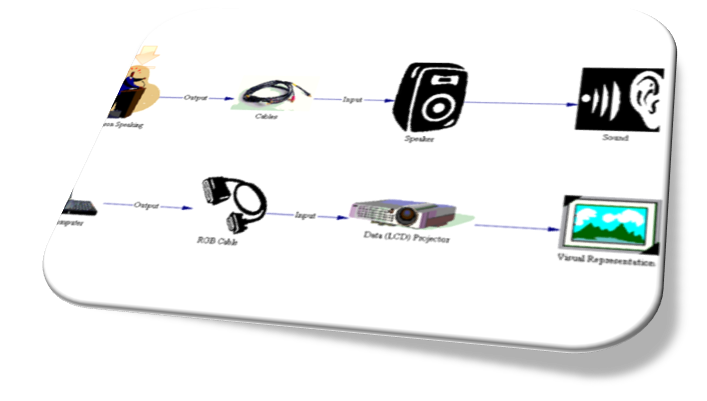
MIT500 - MIT 502 - MIT510 - MIT511 - MIT512 - MIT515 - MIT520 - MIT530 - MIT531 - Internship - Podcasting Project
 |
Self-Instructional Module: Connecting a Data Projector to a Laptop Computer Self Instructional Module (download Flash player) Appendix C - Entry Behaviors Pre-test Appendix E - Learning Context Analysis Appendix F - Performance Objectives
Annotation Context and Conditions This project was completed in Fall 2005 during my first semester with the MIT program. It was completed as a class project under the guidance of Dr. Mahnaz Moallem as a self-instrucitonal module for teachers at Rocky Point Primary School, in Pender County Schools where I was serving as the district Instructional Technology Coordinator. No budget was identified by the district for this project, but we were afforded the use of data projectors and laptop computers for both task analysis and formative evaluation. The graphics were developed using both a digital camera and Inspiration software. Scope This project entailed the analysis, design, development, and evaluation of a self-instructional module for teachers in setting up data projectors in their classrooms. The module was developed using Captivate and distributed on CD accompanying all data projectors. Formative evaluation was conducted at the one-to-one level since it was a self-instructional module. The results affected the final revision of the module. A product plan is included which covers all aspects including: the executive summary, needs assessment, instructional goals, theoretical rationale, learner’s entry behaviors, performance context, performance objective and assessment instruments, instructional strategies, results of one-on-one evaluation, and planning and implementation log. This project was completed in one semester and is currently being used by the teachers of Rocky Point Primary School. Role I served as part of a two-person team with the Technology Facilitator at Rocky Point Primary School. I served as co-instructional designer and multimedia developer. We utilized Richard Mayer’s “Designing Instruction for Constructivist Learning” (or SOI) model as the basis for the module and Dick, Carey and Carey Systems Approach for Designing Instruction (2005) model as a framework for the processes of analysis, design and development. As instructional designers, we conducted front-end analysis which included the needs assessment, learner, environmental and instructional goals analysis. Based on the results of the front end analysis we designed and developed learning goals, performance objectives, assessment strategies, assessment items, and instructional strategies. In the development phase of this project, I constructed the CD-based module using digital photographs and graphic organizers created in Inspiration 7. This was my first attempt at developing a Captivate application would autorun from a CD. Reflection Since this was my first project with the MIT program, my understanding of the impact of front-end analysis and formative evaluation were somewhat limited. Therefore, I tended to focus much of my energy on the development process, leaving the analysis somewhat superficial. As I progressed through the program, front-end analysis became one of my strengths and favorite parts of the ISD process. I also realize now that my formative evaluation skills were lacking and, had we done a better job, more feedback regarding usability of the module would have been noted. |
MIT500 - MIT 502 - MIT510 - MIT511 - MIT512 - MIT515 - MIT520 - MIT530 - MIT531 - Internship - Podcasting Project

